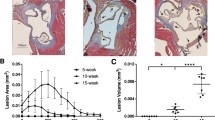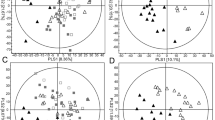Abstract
Introduction
Three out of four people with diabetes will die of cardiovascular disease. However, the molecular mechanisms by which hyperglycemia promotes atherosclerosis, the major underlying cause of cardiovascular disease, are not clear.
Objectives
Three distinct models of hyperglycemia-associated accelerated atherosclerosis were used to identify commonly altered metabolites and pathways associated with the disease.
Methods
Normoglycemic apolipoprotein-E-deficient mice served as atherosclerotic control. Hyperglycemia was induced by multiple low-dose streptozotocin injections, or by introducing a point-mutation in one copy of insulin-2 gene. Glucosamine-supplemented mice, which experience accelerated atherosclerosis to a similar extent as hyperglycemia-induced models without alterations in glucose or insulin levels, were also included in the analysis. Untargeted plasma metabolomics were used to investigate hyperglycemia-associated accelerated atherosclerosis in three disease models. The effect of specific significantly altered metabolites on pro-atherogenic processes was investigated in cultured human vascular cells.
Results
Hyperglycemic and glucosamine-supplemented mice showed distinct metabolomic profiles compared to controls. Meta-analysis of three disease models revealed 62 similarly altered metabolite features (FDR-adjusted p < 0.05). Identification of shared metabolites revealed alterations in glycerophospholipid and sphingolipid metabolism, and pro-atherogenic processes including inflammation and oxidative stress. Post-multivariate and pathway analyses indicated that the glycosphingolipid pathway is strongly associated with hyperglycemia-induced accelerated atherosclerosis in these atherogenic mouse models. Glycosphingolipids induced oxidative stress and inflammation in cultured human vascular cells.
Conclusion
Glycosphingolipids are strongly associated with hyperglycemia-induced accelerated atherosclerosis in three distinct models. They also promote pro-atherogenic processes in cultured human cells. These results suggest glycosphingolipid pathway may be a potential therapeutic target to block or slow atherogenesis in diabetic patients.





Similar content being viewed by others
References
Bietrix, F., Lombardo, E., Roomen, C. P. A. A., Van Ottenhoff, R., Vos, M., Rensen, P. C. N., et al. (2010). Inhibition of glycosphingolipid synthesis induces a profound reduction of plasma cholesterol and inhibits atherosclerosis development in APOE*3 leiden and low-density lipoprotein receptor -/- mice. Arteriosclerosis, Thrombosis, and Vascular Biology, 30, 931–937.
Chalcraft, K. R., & McCarry, B. E. (2013). Tandem LC columns for the simultaneous retention of polar and nonpolar molecules in comprehensive metabolomics analysis. Journal of Separation Science, 36, 3478–3485.
Dang, V. T., Beriault, D. R., Deng, A., Shi, Y., & Werstuck, G. H. (2015). Glucosamine-induced ER stress accelerates atherogenesis: A potential link between diabetes and cardiovascular disease. Journal of Molecular and Genetic Medicine, 9, 4.
Dang, V. T., Huang, A., Zhong, L. H., Shi, Y., & Werstuck, G. H. (2016). Comprehensive plasma metabolomic analyses of atherosclerotic progression reveal alterations in glycerophospholipid and sphingolipid metabolism in apolipoprotein E-deficient mice. Scientific Reports, 6, 35037.
Edsfeldt, A., Dunér, P., Ståhlman, M., Mollet, I. G., Asciutto, G., Grufman, H., et al. (2016). Sphingolipids contribute to human atherosclerotic plaque inflammation. Arteriosclerosis, Thrombosis, and Vascular Biology, 36, 1132–1140.
Falk, E. (2006). Pathogenesis of atherosclerosis. Journal of the American College of Cardiology, 47, C7–C12.
Fiehn, O. (2002). Metabolomics-the link between genotypes and phenotypes. Plant Molecular Biology, 48, 155–171.
Friedrich, N. (2012). Metabolomics in diabetes research. Journal of Endocrinology, 215(1), 29–42.
Glass, C. K., & Witztum, J. L. (2001). Atherosclerosis: The road ahead review. Cell, 104, 503–516.
Goonewardena, S. N., Prevette, L. E., & Desai, A. A. (2010). Metabolomics and atherosclerosis. Current Atherosclerosis Reports, 12, 267–272.
Haffner, S. M., Lehto, S., Ronnemaa, T., Pyorala, K., & Laakso, M. (1998). Mortality from coronary heart disease in subjects with type 2 diabetes and in nondiabetic subjects with and without prior myocardial infarction. The New England Journal of Medicine, 339(4), 229–234.
Hossain, P., Kawar, B., & Nahas, E., M (2007). Obesity and diabetes in the developing world—A growing challenge. The New England Journal of Medicine, 356(3), 213–215.
Juutilainen, A., Lehto, S., Ronnemaa, T., Pyorala, K., & Laakso, M. (2008). Similarity of the impact of type 1 and type 2 diabetes on cardiovascular mortality in middle-aged subjects. Diabetes Care, 31(4), 714–719.
King, A. J. F. (2012). The use of animal models in diabetes research. British Journal of Pharmacology, 166, 877–894.
Kunjathoor, V. V., Wilson, D. L., & LeBoeuf, R. C. (1996). Increased atherosclerosis in streptozotocin-induced diabetic mice. Journal of Clinical Investigation, 97(7), 1767–1773.
Lehto, S., Rönnemaa, T., Pyörälä, K., & Laakso, M. (2000). Cardiovascular risk factors clustering with endogenous hyperinsulinaemia predict death from coronary heart disease in patients with Type II diabetes. Diabetologia, 43(2), 148–155.
Meikle, P. J., & Summers, S. A. (2017). Sphingolipids and phospholipids in insulin resistance and related metabolic disorders. Nature Reviews Endocrinology, 13(2), 79–91.
Meir, K. S., & Leitersdorf, E. (2004). Atherosclerosis in the apolipoprotein E-deficient mouse a decade of progress. Arteriosclerosis, Thrombosis, and Vascular Biology, 24, 1006–1014.
Nakashima, Y., Plump, A. S., Raines, E. W., Breslow, J. L., & Ross, R. (1993). ApoE-deficient mice develop lesions of all phases of atherosclerosis throughout the arterial tree. Arteriosclerosis, Thrombosis, and Vascular Biology, 14(1), 133–140.
Patterson, C. C., Dahlquist, G. G., Gyürüs, E., Green, A., & Soltész, G. (2009). Incidence trends for childhood type 1 diabetes in Europe during 1989–2003 and predicted new cases 2005-20: A multicentre prospective registration study. Lancet, 373(9680), 2027–2033.
Patti, G. J., Yanes, O., & Siuzdak, G. (2012). Metabolomics: The apogee of the omics trilogy. Nature Reviews: Molecular Cell Biology, 13(4), 263–269.
Rauschert, S., Uhl, O., Koletzko, B., Kirchberg, F., Mori, T. A., Huang, R., et al. (2016). Lipidomics reveals associations of phospholipids with obesity and insulin resistance in young adults. Journal of Clinical Endocrinology and Metabolism, 101, 871–879.
Reddick, R. L., Zhang, S. H., & Maeda, N. (1994). Atherosclerosis in mice lacking Apo E. Arteriosclerosis and Thrombosis, 14(1), 141–148.
Ross, R. (1993). The pathogenesis of atherosclerosis: A perspective for the 1990s. Nature, 362(6423), 801–809.
Seshasai, S. R. K., Kaptoge, S., Thompson, A., Di Angelantonio, E., Gao, P., Sarwar, N., et al. (2011). Diabetes mellitus, fasting glucose, and risk of cause-specific death. The New England Journal of Medicine, 364(9), 829–841.
Shalhoub, J., Sikkel, M. B., Davies, K. J., Vorkas, P., Want, E. J., & Davies, A. H. (2014). Systems biology of human atherosclerosis. Vascular and Endovascular Surgery, 48(1), 5–17.
Sumner, L. W., Amberg, A., Barrett, D., Beale, M. H., Beger, R., Daykin, C. A., et al. (2007). Proposed minimum reporting standards for chemical analysis. Metabolomics, 3(3), 211–221.
Venegas-Pino, D. E., Banko, N., Khan, M. I., Shi, Y., & Werstuck, G. H. (2013). Quantitative analysis and characterization of atherosclerotic lesions in the murine aortic sinus. Journal of Visualized Experiments, 82, 50933.
Venegas-Pino, D. E., Wang, P.-W., Stoute, H. K., Singh-Pickersgill, N. A., Hong, B. Y., Khan, M. I., et al. (2015). Sex-specific differences in an ApoE–/–:Ins2+/Akita mouse model of accelerated atherosclerosis. The American Journal of Pathology, 186, 67–77.
Whitman, S. C. (2004). A practical approach to using mice in atherosclerosis research. The Clinical Biochemist Reviews, 25, 81–93.
Wu, K. K., & Huan, Y. (2007). Diabetic atherosclerosis mouse models. Atherosclerosis, 191(2), 241–249.
Xia, J., Sinelnikov, I. V., Han, B., & Wishart, D. S. (2015). MetaboAnalyst 3.0-making metabolomics more meaningful. Nucleic Acids Research, 43, W251–W257.
Zhao, H., Przybylska, M., Wu, I., Zhang, J., Siegel, C., Komarnitsky, S., et al. (2007). Inhibiting glycosphingolipid synthesis improves glycemic control and insulin sensitivity in animal models of type 2 diabetes. Diabetes, 56, 1210–1218.
Zheng, W., Kollmeyer, J., Symolon, H., Momin, A., Munter, E., Wang, E., et al. (2006). Ceramides and other bioactive sphingolipid backbones in health and disease: Lipidomic analysis, metabolism and roles in membrane structure, dynamics, signaling and autophagy. Biochimica et Biophysica Acta, 1758, 1864–1884.
Acknowledgements
The authors would like to thank Dr. Peter Shi for providing the human cell lines for the in vitro experiments and the Centre for Microbial Chemical Biology at McMaster University for access to the Mass Spectrometer. This research was supported by operating grants from the Canadian Institutes of Health Research (MOP62910 and MOP142248) and the Heart and Stroke Foundation of Canada (G-17-0017029). V.T.D. is supported by an International Ontario Graduate Scholarship.
Author information
Authors and Affiliations
Contributions
GHW and VTD conceived and designed the study. VTD and AH performed mouse experiments. VTD, LHZ and AD conducted and analyzed histochemistry and in vitro experiments. VTD performed all metabolomic experiments and analyses. All authors reviewed and approved the final version of the manuscript.
Corresponding author
Ethics declarations
Conflict of interest
Vi Dang, Lexy Zhong, Aric Huang, Arlinda Deng and Geoff Werstuck declare no conflict of interest.
Ethical approval
All animal procedures were pre-approved by, and performed in accordance with, the McMaster University Animal Research Ethics Board and conform with the guidelines of the Canadian Council on Animal Care.
Electronic supplementary material
Below is the link to the electronic supplementary material.
Rights and permissions
About this article
Cite this article
Dang, V.T., Zhong, L.H., Huang, A. et al. Glycosphingolipids promote pro-atherogenic pathways in the pathogenesis of hyperglycemia-induced accelerated atherosclerosis. Metabolomics 14, 92 (2018). https://doi.org/10.1007/s11306-018-1392-2
Received:
Accepted:
Published:
DOI: https://doi.org/10.1007/s11306-018-1392-2




